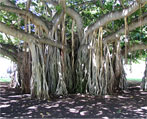



The banyan tree is well known allover India. The tree has what is known as the 'aerial roots'; its branches drop to the ground, take roots again, and send out more twisting and trailing branches, thus extending the growth of the tree indefinitely. It has smooth, shining, rather stiff and leathery leaves, broadly oval in shape. The flowers and fruits are inconspicious, very minute, many of them being held together in the fig, which is a sort of pouch that contains hundreds of flowers or fruits.
The name Banyan tree in English seems to have been given by Europeans in the Persian Gulf to a particular tree of this species under which Banias or members of the Indian merchant class used to congregate for worship and business. Gradually, the name spread to indicate all the species of this tree. From time immemorial, poets and mystics of India have been eloquent in singing the praises of this tree. It is now one of the commonest trees planted along the country roads, shrines, or uncultivated fields in India.
The leaves of the banyan tree yield ficusin and bergaptene. The latex of the tree is very toxic.
The banyan has many medicinal properties. It is used in traditional medicine for the treatment of several ailments. The bark and leaf buds of the tree are useful in arresting secretion or bleeding. The fruit exercises a soothing effect on the skin and mucous membranes,' alleviates swelling and pain, and serve as a mild purgative. It is also nutritious.
The leaf buds of the banyan tree are beneficial in the treatment of chronic diarrhoea and dysentery. The buds should be soaked in water' overnight and taken as infusion in the treatment of these diseases. The latex is also useful in the treatment of diarrhoea and dysentery.
A few drops of the latex of the banyan tree mixed in milk and taken daily helps to cure bleeding piles. With this treatment, the diet of the patient should contain liberal quantities of green vegetables especially fenugreek and manattakkali or black nightshade leaves.
Tender roots of the banyan tree are considered beneficial in the treatment of female sterility. These roots should be dried in the shade and finely powdered. This powder should be mixed 5 times its weight, with milk, and taken at night for 3 consecutive nights after menstruation cycle every month till the conception takes place. No other food should be taken with this.
A regular douching of the genital tract with a decoction of the bark of the banyan tree and the fig tree is helpful in leucorrhoea. A tablespoon each of the powders of the bark of the two trees should be boiled in a litre of water till it is reduced to about half. Douching with the lukewarm decoction will keep the tissues of vaginal tract healthy.
Cleaning the teeth with the aerial roots of the banyan is beneficial in preventing teeth and gum disorders. As one chews the stick and brushes, the astringent secretion from the root-stick cleanses and strengthens the teeth and gums.
The latex is commonly used locally for rheumatism, pain and lumbago.
A hot poultice of the leaves can be applied with beneficial results to abscesses to promote suppuration and to hasten their breaking. The milky juice from the fresh green leaves is useful in destroying warts. The latex is commonly used locally for sores, ulcers and bruises.
Those who do not wear socks and shoes suffer from cracking of heels, a condition known as kibes. The best way to deal with this condition is to fill the cracks with the sap of the banyan tree.
An infusion of the bark is a specific medicine for diabetes. The tender ends of the aerial roots can be taken in obstinate vomiting.
Copyright © Krishna Herbal Company 2022. All Rights Reserved Powered By: Planet Ayurveda







